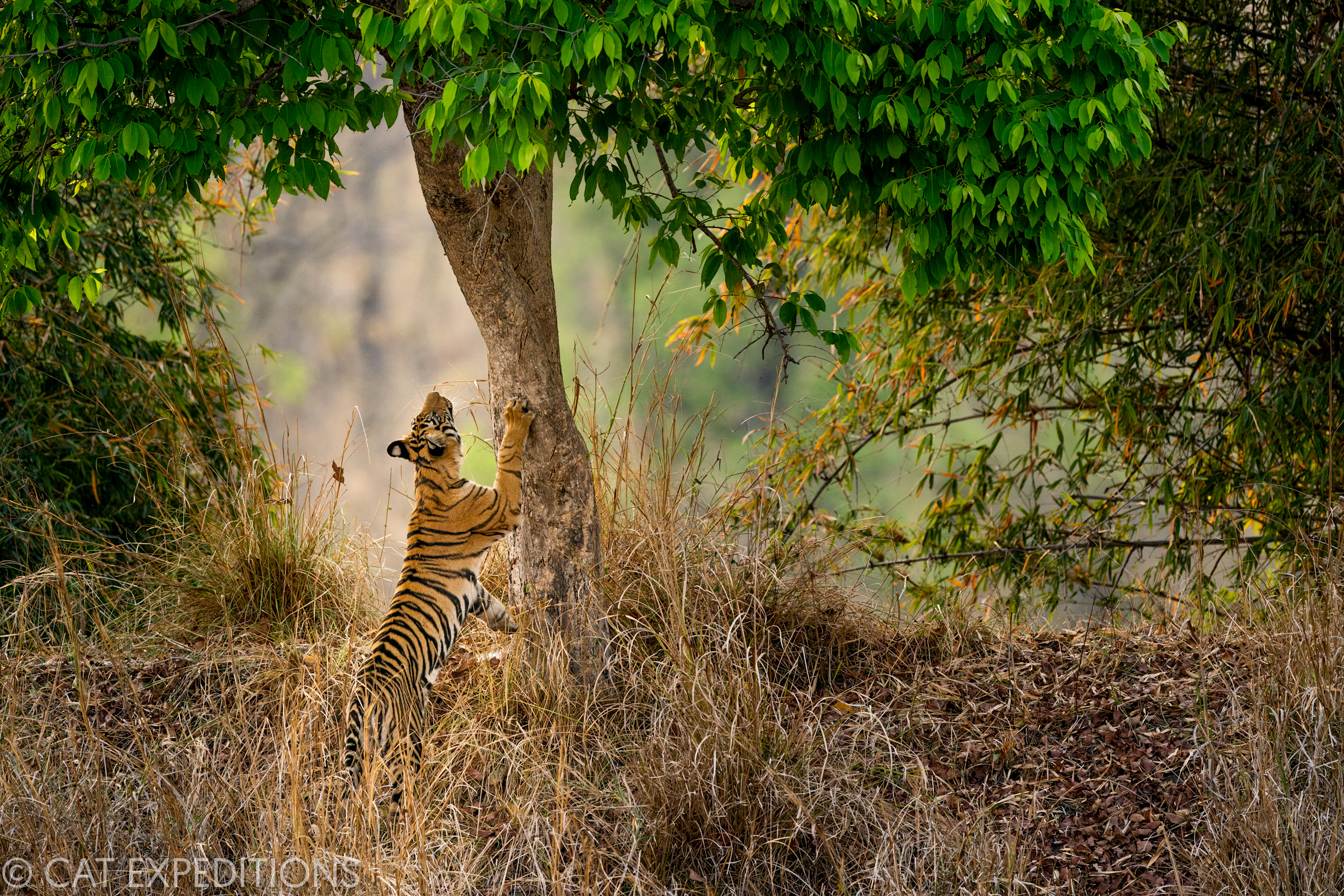Tiger
TIGER (Panthera tigris)
The tiger is the worlds largest cat. It is also the world's only striped cat. Tigers are found in the Russian Far East, in south India, and into southeast Asia. Unlike other big cats, tigers like water, often resting in it to cool off during the warmer months. Like other big cats, tigers tend to hunt prey larger than themselves, including sambar deer and gaur cattle.
Difficulty: Easy
Tiger Tour Statistics
1 TIGER TOUR RUN
26 DIFFERENT TIGERS SEEN
30 MINUTES ON AVG
WITH EACH TIGER
Tiger Description
Tigers are the largest cats in the world, with males weighing on average as much as 306 kgs (675 lb), though an extremely large male from northern Uttar Pradesh, India was one recorded at 389 kg (857 lb). Tigers are extremely powerful cats, with a big head, large shoulders, and powerful forelimbs. Their fur is orange, and is dissected by long, vertical black stripes. In Simlipal National Park tigers display pseudo-melanism, where their black stripes are so thick and close together, the cats appear black in coloration. White tigers are not found in the wild, and are a product of consecutive inbreeding in captivity. Like many other felines, tigers have white spots on the back of their otherwise black ears. This is believed to help tiger cubs follow their moms in the darkness. For our tigers of India tour, we see and photograph Bengal tigers (Panthera tigris tigris), a subspecies of tiger native to India, Bangladesh, Nepal, Bhutan, and China.
Tiger stripes are unique to each individual. Here a one year old cub and sub-adult male show their different stripe patterns in Bandhavgarh National Park, India.
Tiger Distribution and Habitat
Tigers are found in the Russian Far East, the Indian Subcontinent, Sumatra, and the Indochinese Peninsula. Tigers now only occupy 6% of their historical habitat which reached all the way to eastern Turkey. In general, tigers prefer forested habitats. During our tigers of India photo tour, we visit Bandhavgarh National Park and Khana National Parks where tigers live in tropical moist deciduous forests (including Sal forests). Tigers need large areas to roam and find their prey, which is one of their downfalls, as human encroachment has meant an ever shrinking environment for them.
Tigers prefer forested habitats, but also blend in perfectly into grasslands. Can you see the tiger female in the top right part of the photograph, taken in Bandhavgarh National Park in India.
Tiger Feeding Biology
Tigers are naturally diurnal, looking for their prey during the day. When disturbed by humans, tigers become nocturnal, evading the pressures from people by being active at night. Tigers prey upon deer, wild pigs, and wild cattle, but will also opportunistically go after primates, porcupines, birds, rodents, and reptiles. Like the other big cats, tigers employ an ambush strategy, stalking close to their prey, until only a few meters away, to then pounce onto their prey. A kill bite is delivered to the neck or the prey suffocates with the tiger biting its throat. This allows tigers to kill prey six times larger than themselves.
Tigers generally prey on animals bigger than themselves. Here a Bengal tiger stands with its 2500 lbs gaur kill in Bandhavgarh National Park in India.
Tiger Social Organization
Like most other cats, tigers are solitary and territorial. Male ranges encompass at least one female’s range and are larger than those of females. Tigers scent mark and scrape, as well as scratch logs and trees to indicate their territorial boundaries. During our tigers of India tour, we had multiple occasions where we saw multiple tigers at once, occupying the same territory, tolerating each others presence. In one instance we even saw a tigress who already had three cubs, adopt a sub-adult male as part of her family.
A one year old Bengal tiger cub scratches a tree during our tigers of India photo tour. This type of behavior will serve to mark her territory when she is an adult. Photographed in Bandhavgarh National Park, India.
Tiger Reproduction
Tigers can mate all year around, but most cubs are born between March and June. Males have to be quick about finding females, as they are only receptive for up to six days. Like other big cats, male tigers will hang around a female while she is in heat, and mate with her frequently. Gestation lasts an average of 104 days, with the cubs being born in a sheltered location like a cave, or thicket. The up to six cubs (three is the average) open their eyes when they are between six and fourteen days old. Female tigers lactate for up to six months, but tiger cubs start eating meat as early as eight weeks. At six months, tiger cubs start following mom as she moves through her territory. Tiger cubs will start to hunt as early as eleven months, but don't generally become independent until they are 18 to 20 months old. Tigers live up to 26 years in the wild.
Bengal Tiger mother and two year old cub feeding on prey in India. This cub will soon leave her mom to find her own territory.






